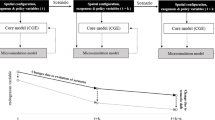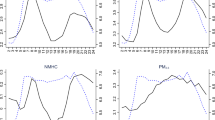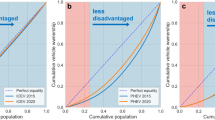Abstract
Low-emission zones (LEZs) have been implemented widely in Europe to tackle air pollution sourced from vehicular emissions. We quantify the effectiveness of the world's largest LEZ—London's LEZ—in reducing its target pollutant, PM10. Using a difference-in-difference (DID) framework, we find that the least stringent phase I of London's LEZ induced a short-term increase in the roadside PM10 within the zone by about 14.8%, whereas the longer and more restrictive phase II significantly drove down the PM10 by 5.5%. We explore the underlying reasons behind the disparity in policy effect across stages. We show that upon the introduction of phase I, the traffic volume of targeted heavy goods vehicles (HGVs) and temporarily exempted light goods vehicles (LGVs) has substantially increased, outweighing the environmental effect of a higher proportion of greener vehicles. We provide possible behavioral explanations for this phenomenon.

source: Traffic for London). Note: Blue boundary—LEZ; Red boundary: London local authority boundary





source is transport for London. b Number of Phase I and Phase II subject vehicles in London. Note: Data source is transport for London
Similar content being viewed by others
Notes
For instance, congestion charge schemes were introduced in major cities like Stockholm and London, aiming at shifting the peak-hour demand for roads. In the United Kingdom, legislation tightening the standards of diesel and petrol fuels used for road transport was updated frequently, while the purchase of green vehicles was among the most heavily subsidized areas. In the year 2018, the low-emission vehicles grant in the UK provides discounted prices to consumers purchasing eligible vehicles through subsidizing dealership by £1,500 to £8,000 based on vehicle type.
Ultra-low sulfur diesel (with a maximum of 15 ppm of sulfur) has been available in the UK since 1999. The sulfur-free requirement further pushes down the standard to 10 ppm.
We explored the impact of the LEZ on an alternative air pollutant, NO2, in London using 33 air quality stations. The results largely conform to those on PM10 and are available upon request.
For complete demonstrations of equivalence of ambient air monitoring methods, see https://ec.europa.eu/environment/air/quality/legislation/pdf/equivalence.pdf
A typical roadside station resides within 1 m from a representative highway or truck road and monitors air quality 2–3 m from the grounTo investigate changesd. According to the LAQN, the reported observations of each station should be representative of air quality in similar geographical locations within a reasonable scope.
We exclude stations with more than 20% missing data on daily PM10 concentrations during our sample period. We also drop stations located along or within 10 miles outside of the LEZ border, as the policy treatment effect inside London is contaminated with potential spillover effect in these areas.
The LOWESS curves reserve both long-run trends and short-term waves, and are robust to extreme outliers (Cleveland 1979).
An alternative way to construct this model is to nest it in Eq. (1) with separate identifiers for inside and nearby stations, respectively. Estimation results using the nested model are highly consistent with those using separate models. Although not showing here due to space constraints, nested model results are available upon request.
This observation period for the estimation of the LEZ effects on vehicle compliance behaviors is shorter than the observation period in our main estimation for two reasons. First, the TfL does not monitor the compliance behaviors of vehicles before the announcement of the LEZ policy. Second, the compliance rate approached above 95% for both phases several months before the end of phase II. Thus, our compliance regressions and figures are produced based on a 2.5-year time window rather than the full length of 6 years in the main specification.
We use linearly interpolated data for two reasons. First, we have a limited number of observations in the early announcement period of the LEZ. However, the earliest stage is expected to carry the most dramatic change in the compliance rate. From Fig. 6a, we also see that approaching the end of the observation window, the compliance rates in both phases grow very slowly. The marginal change over time is minimal, since the compliance rate is capped at 100%. Therefore, we use the interpolated data to extract more variation from the traffic sector to explain the air quality fluctuations at the day level.
For instance, all the weather covariates are now the average of daily level weather conditions throughout the week. We replace the non-workday dummy by the proportion of holidays within a week and replace the no-rain-for-5-days dummy by the proportion of such days within a week. Similarly, we replace all the wind direction indicators by the proportion of days with a certain direction of wind during a week.
Normally, the issue of small sample size can be overcome using a bootstrap method. However, the potential correlation between observations within and across stations may challenge the validity of bootstrap in our setting. With the assumption of no across-cluster (i.e., across-station) dependence of data, we performed 200 bootstrap replications with resampling based on stations and obtained bootstrapped estimation results that are highly consistent with our main findings. We are glad to provide these results upon request.
References
Anderson ML (2020) As the wind blows: The effects of long-term exposure to air pollution on mortality. J Eur Econ Assoc 18(4):1886–1927
Archsmith J, Heyes A, Saberian S (2018) Air quality and error quantity: pollution and performance in a high-skilled, quality-focused occupation. J Assoc Environ Res Econ 5(4):827–863
Arkes HR, Blumer C (1985) The psychology of sunk costs. Organ Behav Hum Decis Process 35:124–140
Boogaard H, Janssen NAH, Fischer PH, Kos GPA, Weijers EP, Cassee FR et al (2012) Impact of low emission zones and local traffic policies on ambient air pollution concentrations. Sci Total Environ 435–436:132–140
Carslaw DC, Beevers SD (2002) The efficacy of low emission zones in central london as a means of reducing nitrogen dioxide concentrations. Transp Res Part D 7:49–64
Cesur R, Tekin E, Ulker A (2017) Air pollution and infant mortality: evidence from the expansion of natural gas infrastructure. Econ J 127(600):330–362
Chang T, Zivin JG, Gross T, Neidell MJ (2016) Particulate pollution and the productivity of pear packers. Am Econ J Econ Policy 8(3):141–169
Chang T, Zivin GJ, Gross T, Neidell M (2019) The effect of pollution on worker productivity: evidence from call center workers in China. Am Econ J Appl Econ 11(1):151–172
Chay KY, Greenstone M (2003) The impact of air pollution on infant mortality: evidence from geographic variation in pollution shocks induced by a recession. Q J Econ 118(3):1121–1167
Chen S, Guo C, Huang X (2018) Air pollution, student health, and school absences: evidence from China. J Environ Econ Manage 92(2018):465–497
Chen Y, Ebenstein A, Greenstone M, Li H (2013) Evidence on the impact of sustained exposure to air pollution on life expectancy from China’s huai river policy. In: Proceedings of the National Academy of Sciences (PNAS) of the United States of America, vol 110(32), p 12936–12941.
Cleveland WS (1979) Robust locally weighted regression and smoothing plots. J Am Stat Assoc 74(1979):829–836
Currie J, Hanushek EA, Kahn EM, Neidell M, Rivkin SG (2009) Does pollution increase school absence? Rev Econ Stat 91(4):682–694
Davis L (2008) The effect of driving restrictions on air quality in Mexico City. J Polit Econ 116(1):38–81
Ebenstein A, Lavy V, Roth S (2016) The long-run economic consequences of high-stakes examinations: evidence from transitory variation in pollution. Am Econ J Appl Econ 8(4):36–65
Ellison RB, Greaves SP, Hensher DA (2013) Five years of London’s low emission zone: effects on vehicle fleet composition and air quality. Transp Res Part D 23:25–33
European Environmental Agency (EEA) (2013) Air Quality in Europe - 2013 Report. European Environment Agency, Copenhagen
European Environmental Agency (EEA) (2015) Air quality in Europe—2015 Report. European Environment Agency, Copenhagen
European Environmental Agency (EEA) (2016) Explaining road transport emissions: a non-technical guide. European Environmental Agency, Copenhagen
Environmental Protection Agency (EPA). (2020). Fast facts: U.S. transportation sector greenhouse gas emissions, 1990–2018 (EPA-420-F-20–037, June 2020).
Ferm M, Sjöberg K (2015) Concentrations and emission factors for PM2.5 and PM10 from road traffic in Sweden. Atmos Environ 119:211–219
Gehrsitz M (2017) The effect of low emission zones on air pollution and infant health. J Environ Econ Manage 83:121–144
Green CP, Heywood JS, Navarro M (2016) Traffic accidents and the London congestion charge. J Public Econ 133:11–22
Hanna R, Oliva P (2015) The effect of pollution on labor supply: evidence from a natural experiment in Mexico City. J Public Econ 122:68–79
He J, Liu H, Salvo A (2019) Severe air pollution and labor productivity: evidence from industrial towns in China. Am Econ J Appl Econ 11(1):173–201
Heutel G, Ruhm CJ (2016) Air pollution and procyclical mortality. J Assoc Environ Res Econ 3(3):667–706
Ho T, Png IPL, Reza S (2018) Sunk cost fallacy in driving the world’s costliest cars. Manage Sci 64(4):1761–1778
Holman C, Harrison R, Querol X (2015) Review of The efficacy of low emission zones to improve urban air quality in European Cities. Atmos Environ 111:161–169
Harrison RM, Yin J, Mark D, Stedman J, Appleby RS, Booker J, Moorcroft S (2001) Studies of the coarse particle (2.5–10 μm) component in UK urban atmospheres. Atmos Environ 35(2001):3667–3679
Jones AM, Harrison RM, Barratt B, Fuller G (2012) A large reduction in airborne particle number concentrations at the time of the introduction of sulphur free diesel and the London low emission zone. Atmos Environ 50:129–138
Leape J (2006) The London congestion charge. J Econ Perspect 20(4):157–176
Kahneman D, Tversky A (1979) Prospect theory: an analysis of decision under risk. Econometrica 47(2):263–292
Kelly F, Armstrong B, Atkinson R, Anderson HR, Barratt B, Beevers S, et al, HEI Health Review Committee. (2011). The London low emission zone baseline study. Res Rep Health Eff Inst, 163: 3-79
Mudway IS, Dundas I, Wood HE, Marlin N, Jamaludin JB, Bremner SA et al (2019) Impact of London’s low emission zone on air quality and children’s respiratory health: a sequential annual cross-sectional study. Lancet Public Health 4(1):E28–E40
Rittenhouse K, Zaragoza-Watkins M (2018) Anticipation and environmental regulation. J Environ Econ Manage 89(C):255–277
Thaler R (1980) Toward a positive theory of consumer choice. J Econ Behav Organ 1:39–60
Thaler R (1983) Transaction utility theory. In: Bagozzi RP, Tybout AM, Abor A (eds) NA—advances in consumer research, vol 10. MI, Association for Consumer Research, pp 229–232
Tonne C, Beevers S, Armstrong B, Kelly F, Wilkinson P (2008) Air pollution and mortality benefits of the London congestion charge: spatial and socioeconomic inequalities. Occup Environ Med 65:620–627
Transport for London (TfL). (2010). Travel in London—report 3. London, UK: TfL. http://content.tfl.gov.uk/travel-in-london-report-3.pdf. Accessed Sep 2019.
Transport for London (TfL). (2011). Stricter emissions standards for central or inner London: a provisional assessment of potential feasibility and effectiveness. London, UK: TfL. http://www.london.gov.uk/sites/default/files/Central%20and%20Inner%20London%20LEZ%20Feasibility%20Study.pdf. Accessed Sep 2019.
Watkiss P, Allen J, Anderson S, Beevers S, Browne M, Carslaw D et al (2003). London low emission zone feasibility study. Phase II. Final report to the London low emission zone steering group. AEA Technology Environment. July 2003.
Wolff H (2014) Keep your clunker in the suburb: low emission zones and adoption of green vehicles. Econ J 124:F481–F512
Wolff H, Perry L (2010) Trends in clean air legislation in Europe: particulate matter and low emission zones. Rev Environ Econ Policy 4(2):293–308
World Health Organization (WHO) (2015) Economic cost of the health impact of air pollution in Europe: clean air, health and wealth. World Health Organization, Regional Office for Europe, Copenhagen
Zivin GJ, Neidell M (2012) The impact of pollution on worker productivity. Am Econ Rev 102(7):3652–3673
Author information
Authors and Affiliations
Corresponding author
Additional information
Publisher's Note
Springer Nature remains neutral with regard to jurisdictional claims in published maps and institutional affiliations.
The authors would like to express sincere appreciations to Robert Halvorsen, Jim LeSage, Neil Bruce, Judy Thornton, David Layton, Jing Tao, Yoram Barzel, Aseem Prakash, and Jorge Rojas for their helpful comments on the paper. All remaining errors are our own.
Supplementary Information
Below is the link to the electronic supplementary material.
About this article
Cite this article
Zhai, M., Wolff, H. Air pollution and urban road transport: evidence from the world’s largest low-emission zone in London. Environ Econ Policy Stud 23, 721–748 (2021). https://doi.org/10.1007/s10018-021-00307-9
Received:
Accepted:
Published:
Issue Date:
DOI: https://doi.org/10.1007/s10018-021-00307-9




